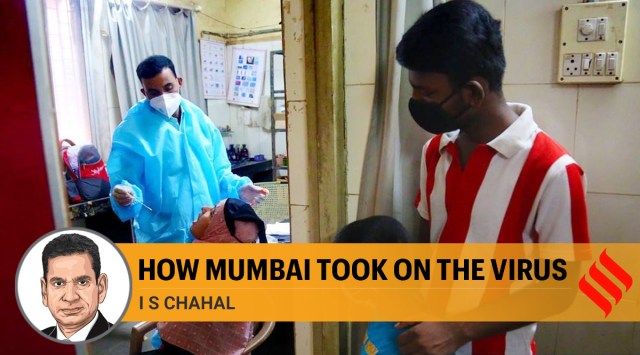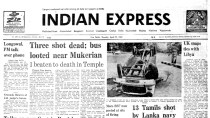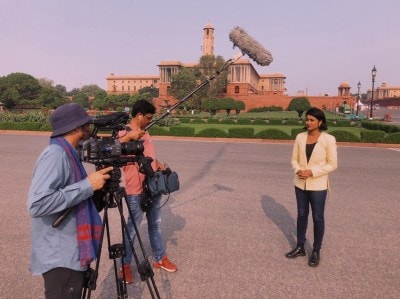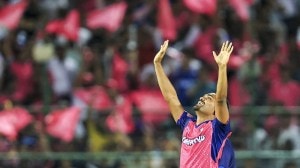- India
- International
Covid in Mumbai: The municipality led a decentralised effort to increase testing, tracing, hospital beds
We identified four pillars on which the fight against COVID-19 would stand — testing, ambulances, COVID beds and abundant trained doctors/ paramedics. Testing, tracing, tracking, quarantine and treatment became the credo of our work.
 At a Covid testing centre in Mumbai.
At a Covid testing centre in Mumbai.Ever since the first COVID-19 case was detected in Mumbai in mid-March, the city has been in the news for the wrong reasons. The contagion spread like wildfire in March and April. The well-known slums, Dharavi, Deonar Bainganwadi, Govandi, Ghatkopar and Worli Koliwada, were teeming with the infection. The death rate touched 8 per cent and there were rumours of innumerable deaths in Mumbai. In the first week of May, a few dead bodies were found on the city’s streets and road dividers. Social media was flooded with videos of dead bodies on roads or in hospitals, several of them on beds, adjacent to those with patients still receiving treatment.
The Centre’s monitoring team visited Mumbai on May 5 and expressed fears of thousands of deaths in the city in the near future. Critics demanded that Mumbai be handed over to the army. Panic had gripped the city. I took over as Mumbai’s municipal commissioner May 8. Early next day, I took stock of the COVID-19 ICUs of major BMC hospitals. This was followed by a 4-km long march to the containment zones of Dharavi to understand the situation in the slums.
We identified four pillars on which the fight against COVID-19 would stand — testing, ambulances, COVID beds and abundant trained doctors/ paramedics. Testing, tracing, tracking, quarantine and treatment became the credo of our work. In the next 10 weeks, the Municipal Corporation of Greater Mumbai (MCGM) ensured a massive increase in health infrastructure. The number of COVID-19 beds were increased from 3,700 on May 8 to 22,300, with ICU beds increasing from 480 to 1,957 — there was a manifold increase in ventilator beds. Team MCGM rose to the occasion.
The availability of COVID-19 test results in 24 hours was made mandatory. Thousands of health workers visited slums and containment zones for door-to-door surveillance and focused testing. More than a million RT-PCR tests were conducted in the city. There was a 10-fold increase in the number of ambulances, from 80 to 826. We ensured that they were available on the Uber platform, free of cost. More than a thousand doctors and paramedics were roped in, including retired government doctors. Around 900 MBBS interns were deployed to manage the war rooms in the city’s 24 wards.
Opinion | Smart testing and contact tracing will remain key to Covid containment

An innovative and extremely aggressive “Chase the Virus Policy” was implemented and lakhs of high-risk contacts were shifted from the slums and placed in institutional quarantines to shield them from the contagion; 48,000 institutional quarantine beds were created. Decentralised hospital bed management along with the “Chase the Patient” policy proved a “game changer”.
Senior IAS officers were deputed to hospitals to supervise operations. Mumbai became the first city in India to fully regulate COVID-19 beds in 35 major and 73 other private hospitals at government rates through a single online dashboard. This was implemented with an iron hand. A world-class online platform for dialysis management for COVID-19 patients was operationalised. Nine centrally air-conditioned jumbo field hospitals with ICU and dialysis beds were established and Mumbai became the first city in India to successfully build and operate them. Walk-in facilities of beds for suspected COVID-19 patients were created all over the city to treat suspected patients without test reports. Dashboards were created in hospitals to provide information on crematoriums.
“Mission Save Lives” for hospitalised patients led to a reduction of mortality rate from 8 per cent to under 2 per cent. Compensation of Rs 50 lakh was given to MCGM/BEST staff who had succumbed to the disease and were not covered under the Government of India’s insurance scheme for frontline COVID workers.
The “My Family My Responsibility” campaign was implemented for two months – 12,000 health workers reached out to 3.5 million families twice for surveillance and health checkups. The “No Mask no Entry” campaign was launched. Posters and stickers bearing the message came up at bus stops, buses, taxis, shops and offices. More than 5 lakh people were fined for not wearing masks.
iPads with Wifi facilities were distributed to COVID-19 positive patients admitted to hospitals to facilitate interaction between them and their relatives — this, we felt, was important to address psychological issues faced by the patients. Plasma banks were created in major BMC hospitals and the drug protocol was standardised.
In the last week of November, the city had less than 10,000 active cases, the doubling rate had increased to 218 days, the rate of infection had fallen to 0.3 per cent, the positivity rate was down to 6 per cent and the monthly mortality rate was below 2 per cent. More than 90 per cent patients are now discharged from hospitals. The situation did not deteriorate in Mumbai during the festive season.
Opinion | Vaccines are powerful but not perfect tools. Application in a diverse country is a challenge
The virus is an unpredictable adversary. Till there is a vaccine for mass use, spurts in infection cannot be ruled out. Worldwide, cities ride the crest and trough of the viral surge with tragic consequences. The war against the virus is far from over. Team MCGM resolves not to be complacent so that we can make Mumbai one of the country’s safest metros during and after the pandemic.
This article first appeared in the print edition on December 5, 2020 under the title ‘How Mumbai took on the virus’. The writer is municipal commissioner, MCGM, Mumbai.
EXPRESS OPINION
Must Read
More Explained
Apr 23: Latest News
- 01
- 02
- 03
- 04
- 05









































